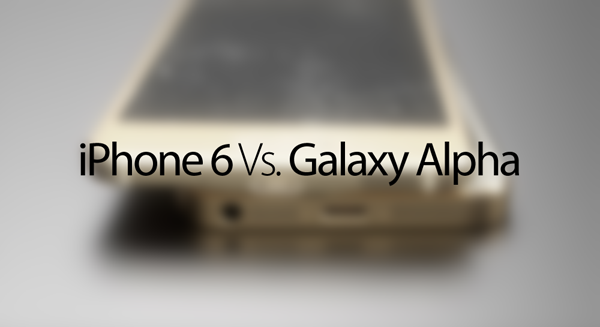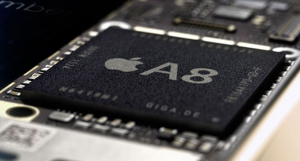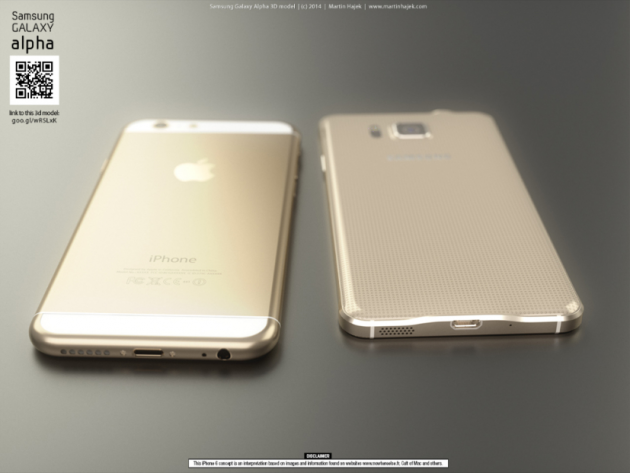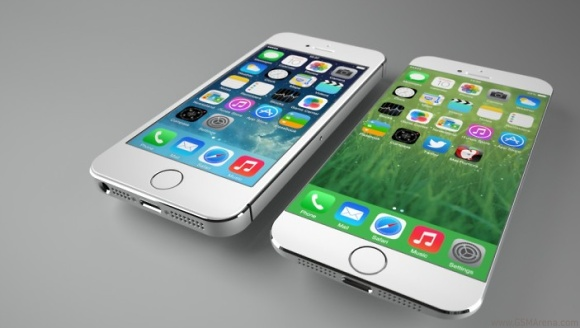Galaxy Alpha vs. iPhone 6 – Which Will Be the Phone to Buy in 2014?
Just when you think Apple's iPhone series might have an edge on Samsung's Galaxy series you find out there's a new and much-improved version of the Galaxy coming out, and it is boldly named the “Alpha.” The new phone is actually more like a redesigned version of the S5, even having the moniker “Galaxy S5 Prime” in some circles.
Although neither phone has been officially released yet, leaving much open to speculation, many leaks, rumors, and facts have been shared with the tech community. Furthermore, Samsung took the initiative to unveil the official specs for the Alpha last week, about a month earlier than the anticipated iPhone 6 launch event.
Let's take a look at how the Galaxy Alpha will compare to the iPhone 6 in every aspect, based on what we know so far:
-
Processing Power
Both the Galaxy Alpha and the iPhone 6 are expected to come equipped with impressive processing power. The iPhone 6 will be debuting the new A8 processor, the performance of which is yet to be tested or experienced by consumers. However, we do know that Apple has made it somewhat of a tradition to practically double the power of its ARM-based A series chips with each generation of devices.
According to reports, the iPhone 6's A8 processor chip will pack a 2GHz 64-bit CPU, making it the first chipset from Apple to reach 2GHz clockspeed. There have even been suggestions that the A8 could run at a stunning 2.6GHz, although there are rumors that this could be a more powerful version of the A8 reserved for the next generation of iPads. There are also reports that the new chipset will utilize 2 GB of RAM.
With all of that said, the Galaxy Alpha will be quite a powerhouse in its own right, with a new Exynos 5 Octa 5430 chipset that is expected to be faster than the latest and greatest Snapdragon 805 chips that are expected to appear in the Nexus 6 and Galaxy Note 4. That means this smartphone could be even more powerful than its tablet counterparts.
Winner: Given that the phones will run on different operating systems, which causes them to utilize their hardware differently, we're calling this one a draw for now – both devices are going to be lightning fast, with very little noticeable difference in speed and performance to the average consumer.
-
Design Specs and Materials
Although the official size of the iPhone 6 has not yet been specified, and might not be until the pre-launch event on September 9th, numerous mockups and rumors from relatively reliable sources have shown the iPhone 6 to be about the same size as the Galaxy S5 at 5.59 inches long by 2.85 inches wide, which to some people isn't a good thing because at that size the S5 packs a larger display of 5.2 inches.
At only 6.7mm thick, the Galaxy Alpha is set to be the thinnest smartphone to ever reach the market, and it should be easier to handle with one hand given its manageable size of 5.21 inches long by 2.58 inches wide. This makes the Alpha, slimmer, thinner, and less lengthy than the iPhone 6, despite having a screen that is the exact same size.
The Alpha will be the first of the Galaxy series to contain a metal casing, but the metal does not extend all the way around the phone – the back cover is still plastic, while the edges are metal. As far as the screen goes, Samsung is expected to continue using Corning Gorilla Glass.
On the other hand, the iPhone 6 is getting rid of the glass rear cover and is covering the entire phone in metal, except of course the display, which is rumored to be made of a special new material. Rumors suggest that the 4.7 inch version may utilize a different display type than the 5.5 inch version that will be released later on, which might have an ultra-durable, scratch-resistant sapphire-based screen.
Graphical modeling expert Martin Hajek has taken all of the design information available so far and has rendered the two devices in 3D to give consumers the chance to see them side by side before the launch. Yesterday Forbes published what might be the best look at the iPhone 6 design thus far. You can also head over to Samsung.com for a better look at the Alpha's design.
3D mockups of the iPhone 6 and Galaxy Alpha next to each other:
Winner: The Alpha seems to have an edge over the iPhone 6 in regard to comfort, as it is slimmer and although the two have the same display size at 4.7 inches, it has a much more compact bezel that makes the phone easier to handle. In regard to sturdiness, Samsung's decision to move from plastic to metal finally puts the design durability in the same league as the iPhone.
-
Display Resolution and Size
Surprisingly, Samsung seems to have made the decision to step down from the 5.2 inch display of the S5 to 4.7 inches for the Alpha – the same size as the smaller version of the iPhone 6. Thus, if you're looking for the largest display, your best bet may be to wait until Apple releases the 5.5 inch version of the iPhone 6. That may seem kind of odd to some smartphone aficionados, as we're used to seeing the Galaxy series with significantly larger displays.
As far as resolution goes, the iPhone 6 seems to have the edge here, with a stunning display resolution of 1704 x 960, which given the size of the display gives it a pixel density of 416 pixels per inch (PPI). That's slightly better than the Alpha's display, which is expected to come in at only 1280 x 720, giving it only 320ppi.
Given that the two resolutions are both close to 326ppi – the mark that Apple has stated is the point where your eyes can no longer distinguish individual pixels, it will be interesting to see how much of a visual difference the extra pixels will make for the iPhone 6.
Most analysts find it odd that Samsung seems to be downgrading from the Full HD 1920 x 1080 resolution that it usually gives it flagship phones, but then again the company has been using AMOLED displays since the S5 and supposedly will be an improved version of the technology in the Alpha's display. We'll have to see whether the bright, standout HD Super AMOLED screens will be enough to persuade consumers away from Apple's less dramatic-looking, yet higher resolution IPS displays.
The iPhone 6's display in 4.7-inch and 5.5-inch form:
Several views of the Galaxy Alpha's display and design profile:
Winner: On paper it seems that the iPhone 6's display has a slight edge over the Galaxy Alpha's, especially in the larger 5.5 inch version. Still, it remains to be seen how impressive the Alpha will look in person.
-
Storage Space
The Alpha will come with a built-in storage capacity of 32GB, which in itself is not bad, but we are somewhat disappointed to learn that there is no talk of a 64GB version yet – that could change though. Perhaps even more shocking is the fact that Samsung has done away with the MicroSD slot in the Alpha, which could be a massive turnoff for many consumers. The iPhone 6 will be available in several versions, up to 64 GB, and there are even rumors that the 5.5-inch version could house an unforeseen 128GB of storage space.
Winner: The iPhone 6 appears to be more data-friendly, with a 64GB version that the Alpha doesn't yet offer and rumors of an unparalleled 128GB edition in the 5.5-inch version.
-
Camera Capabilities
Samsung has made the surprising decision to stick with only 12 megapixels in the Alpha's camera, despite the S5 already packing a 16-megapixel camera. However, we do know that the Alpha's camera sensor will support real-time High Dynamic Range (HDR) capabilities, which essentially lets you see the camera balancing light in real-time before taking the shot. Last week some of the first pictures taken with the Alpha's camera surfaced online. Of course, the Alpha will have a front-facing camera for selfies, and Apple should include a similar front-facing sensor in the iPhone 6.
By contrast, Apple is stepping its megapixel game up a notch, moving up from an 8-megapixel lens in the iPhone 5S to a new 13-megapixel Exmor IMX220 sensor from Sony – the latest advancement in the same line of Sony lenses found in previous iPhones. Rumors suggest that the camera will have a protruding lens, which could make it easier for users to install detachable third-party lenses. Furthermore, the 5.5-inch version is expected to support Optical Image Stabilization (OIS).
Winner: Given that both versions of the iPhone 6 will have a camera with a higher megapixel count, with the 5.5-inch version even supporting OIS, and the extra add-on of enhanced third-party lens compatibility, on paper it seems that Apple is a step ahead in this regard. Still, the Alpha's HDR-capable camera could become a favorite as well, so we're calling this one a draw until we actually have the opportunity to test the cameras in person.
-
Battery Specs
We've already seen Samsung making fun of iPhone batteries in advertisements. As a result, this time around it seems Apple could be taking the battery life of its new iPhone serious, with an expected battery capacity of 1,810mAh. That's a bit higher than the iPhone 5S's capacity of 1,560mAh. However, that doesn't necessarily mean that the new iPhone will have a much longer battery life than its predecessor, as it will need that extra capacity to power the larger display. Still, with the enhanced efficiency of iOS8 and the new A8 chip, it is possible we could see a significant improvement.
Samsung on the other hand has seemingly downgraded in yet another aspect, giving the Alpha a battery capacity of 1860mAh, which is much less than the S5's 2800mAh battery. Still, we should reiterate that mAh capacity does not necessarily translate to battery life, as the operating system and chipset play a huge role as well, and with the new energy-efficient Exynos 5 Octa 5430 and a lower screen resolution, chances are that the Alpha's battery life will remain comparable to the S5's.
Winner: Although Samsung historically prevails in this department, being that both devices' batteries will have a similar mAh and efficient chipsets, we'll have to call this one a draw until consumers are able to judge the actual battery life for themselves.
- Release Dates and Pricing
Although the Alpha has not been given an exact release date yet, Samsung did make an official launch announcement on August 13th stating that the device would reach stores in early September. That means it could hit the market slightly before the iPhone 6, which will be given an exact release date at Apple's pre-launch event scheduled for September 9th.
As far as pricing goes, some analysts expect the Alpha to debut at the same price as the S5 with a contract, but it is currently available for pre-order from MobileFun.co.uk at the high price of about $923 for the SIM-free version.
Not much information has been released about the price of the new iPhone, but we expect it to be very close to the price of iPhone 5S, which would be $199 with a 24-month contract for the 4.7-inch version, or $299 with a 24-month contract for the 5.5 inch version. Still, the SIM-free version will probably cost closer to $900-$1000 at launch.
Winner: Obviously, we'll have to wait to see which device hits the market first, at which point we'll be able to compare pricing, but so far we like Samsung's approach of officially announcing the launch at least a month before the release date - Apple should know we're an impatient crowd.
Conclusion
Ultimately, your decision will probably be based on your own opinion of how much you like the physical look and feel of the devices once you're actually able to test them out, as well as whether you prefer the new iOS over Android. Most iPhone fans are probably already intent on picking up the iPhone 6 as soon as it drops, but there could be a surprising amount of techies that make the switch to the Galaxy series this year. Likewise, with Apple's switch to larger displays, and Samsung's choice to downgrade on some specs, we could see more interest in the iPhone than ever before.
What About the Other Competition?
Other than the Alpha, the iPhone 6 will be in direct competition with LG's G3 and HTC's One M8, and in some ways it'll be competing with the Galaxy S5 as well. To learn more about how the iPhone 6 compares with the other smartphones it will be competing with on its release date, see our “How Does it Stack Up Against the Competition” comparison. Alternatively, to learn more check out everything we know about the iPhone 6 so far.





